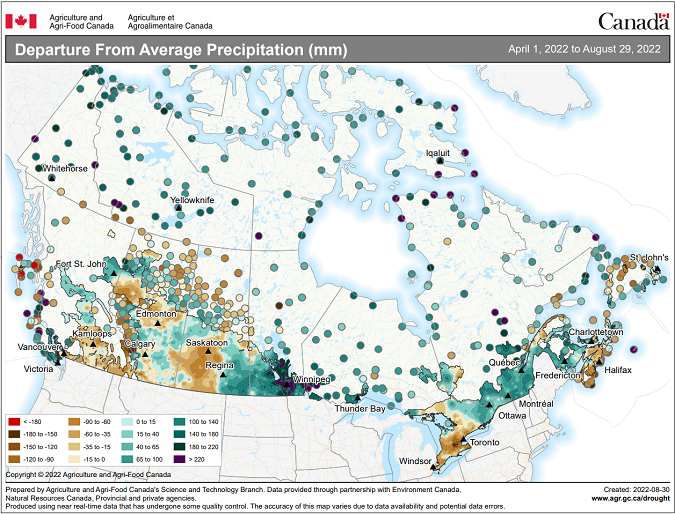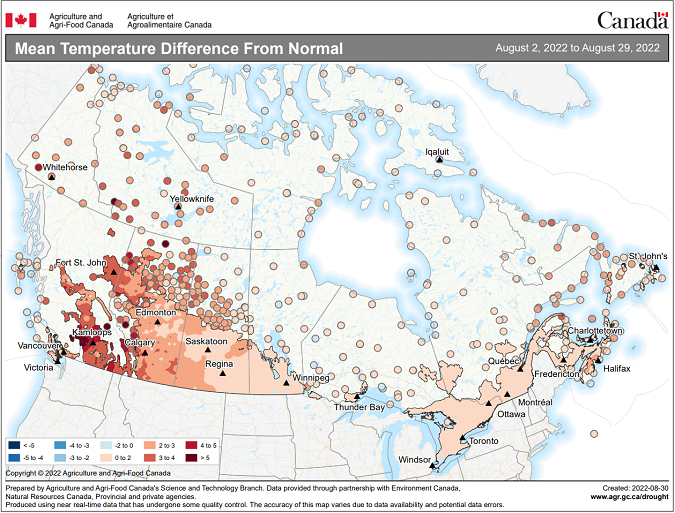Model-based principal field crop estimates, August 2022
Released: 2022-09-14
In 2022, Canadian farmers are projected to produce more wheat, canola, barley, oats, soybeans and corn for grain than they did in 2021, according to the most recent yield model estimates using satellite imagery and agroclimatic data. Increased production was largely driven by higher yields because of better growing conditions in Western Canada.
Statistics Canada, in collaboration with Agriculture and Agri-Food Canada, has relied upon proven satellite technology to model preliminary crop yields and production since 2016. These methods have been used successfully for the past six years to produce September yield estimates, and they replaced July yield estimates beginning in 2020. The September publication of the Crop Reporting Series is a joint release between Statistics Canada and Agriculture and Agri-Food Canada.
The Crop Condition Assessment Program indicates that plant health in Western Canada varied as of August 31. In areas that received sufficient precipitation and warm temperatures, crop condition is considered higher than normal. In some drier areas that experienced higher-than-average temperatures throughout August, crop condition deteriorated and is now considered lower than normal. Despite the Normalized Difference Vegetation Index exceeding normal magnitude for most areas in Western Canada midway through the 2022 growing season, growing conditions throughout the month of August may have decreased yield potential in some areas.
Despite potentially reduced yields, conditions across Western Canada are generally more favourable than in 2021. Much of the Prairies have received consistent precipitation since June, except for southwestern and central parts of Saskatchewan.
In Eastern Canada, much of southern Ontario has experienced drier-than-average conditions, while eastern parts of Ontario and most of Quebec received higher-than-average rainfall. In general, temperatures over the last month of the growing season were warmer than normal as of August 31.
Wheat production is expected to increase on higher harvested area and better yields
Nationally, wheat production is projected to increase by 55.6% year over year to 34.7 million tonnes in 2022. This increase is largely attributable to higher anticipated yields, which are expected to rise by 42.1% to 51.3 bushels per acre, roughly in line with the five-year average of 51.0 bushels per acre from 2016 to 2020. Harvested area is also expected to increase by 9.4% to 24.9 million acres.
The increase in expected total wheat production is largely attributable to spring wheat, which is anticipated to rise by 60.3% to 26.1 million tonnes. This increase is a result of higher anticipated yields (+42.4% to 53.7 bushels per acre) and harvested area (+12.5% to 17.8 million acres).
Durum wheat yields are also anticipated to rise (+90.1% to 38.4 bushels per acre), contributing to higher expected production (+101.3% to 6.1 million tonnes).
Wheat yields in Saskatchewan are expected to rise by 54.8% to 43.5 bushels per acre in 2022, while harvested area is projected to rise by 12.5%, resulting in a 74.0% increase in production to 15.4 million tonnes.
Compared with 2021, wheat production in Alberta is projected to increase by 80.1% to 11.6 million tonnes, which is largely the result of higher yields (+64.9% to 57.4 bushels per acre), while harvested area is expected to rise by 9.3% to 7.4 million acres.
In Manitoba, wheat harvested area is expected to rise by 11.4% to 3.2 million acres, while yields are anticipated to increase by 23.8% to 59.3 bushels per acre. Total wheat production is anticipated to rise by 37.8% year over year to 5.2 million tonnes.
Wheat production in Ontario (the majority of which is winter wheat) is projected to fall by 22.7% to 2.2 million tonnes year over year in 2022 as a result of lower harvested acres (-20.6%) and yields (-2.7%).
Higher anticipated yields push canola production higher
Nationally, in 2022, canola production is expected to rise by 38.8% to 19.1 million tonnes, as growing conditions in the Prairies improved considerably relative to 2021. While the rise pushed yields higher (+44.9% to 39.7 bushels per acre), they are below the five-year average of 41.5 bushels per acre from 2016 to 2020.
Saskatchewan is expected to produce 43.5% more canola in 2022 than in 2021, at 9.7 million tonnes. Yields are projected to increase by 51.2% to 37.8 bushels per acre, while harvested area is expected to fall by 5.1% to 11.3 million acres.
Canola production in Alberta is expected to increase by 40.3% to 6.1 million tonnes. Higher yields (+44.3% to 41.7 bushels per acre) are expected to offset the decrease in harvested area (-2.8% to 6.4 million acres).
In Manitoba, yields are expected to rise by 30.0% to 42.5 bushels per acre, offsetting a projected 3.8% decrease in harvested area to 3.3 million acres, resulting in a 25.0% production increase to 3.1 million tonnes.
Corn for grain production is projected to increase on higher yields
Nationally, corn for grain production is projected to increase by 6.3% to 14.9 million tonnes in 2022, with yields anticipated to rise to 164.3 bushels per acre (+2.6%) and harvested area expected to rise to 3.6 million acres (+3.6%).
In Ontario, the largest corn for grain-producing province, production is expected to rise by 3.5% to 9.8 million tonnes on higher harvested area (+5.0% to 2.2 million acres), offsetting lower yields (-1.5% to 172.6 bushels per acre).
Corn for grain production in Quebec is projected to rise by 3.9% to 3.6 million tonnes. Yields are expected to rise by 3.3% to 157.7 bushels per acre, while harvested area is expected to edge up by 0.6% to 887,400 acres.
Soybean production is expected to rise on higher yields
Nationally, soybean production is projected to increase by 3.7% year over year to 6.5 million tonnes in 2022. Yields are expected to rise by 5.5% to 46.1 bushels per acre, while harvested area is anticipated to decrease by 1.7% to 5.2 million acres.
Soybean production in Ontario is expected to edge up 0.7% in 2022 to 4.1 million tonnes. Harvested area is expected to rise by 5.5% to 3.1 million acres, while yields are anticipated to fall 4.5% to 49.3 bushels per acre.
In Manitoba, soybean production is projected to increase by 23.7% to 1.2 million tonnes in 2022. Harvested area is projected to decrease by 14.3% to 1.1 million acres. However, yields are projected to rise by 44.3% year over year to 39.1 bushels per acre because moisture conditions have improved.
In Quebec, soybean production is projected to increase by 4.7% to 1.2 million tonnes on higher anticipated yields (+0.9% to 44.6 bushels per acre), while harvested area is expected to rise by 3.7% to 950,900 acres.
Barley and oat production is projected to rise
Higher barley yields compared with 2021 (+59.1% to 68.4 bushels per acre) are projected to more than offset lower anticipated harvested area (-14.8% to 6.3 million acres). As a result, barley production is expected to rise by 35.5% year over year to 9.4 million tonnes in 2022.
Oat production is projected to rise by 65.7% to 4.7 million tonnes. Harvested area is expected to increase by 10.6% to 3.2 million acres, and yields are expected to rise by 50.0% year over year to 93.9 bushels per acre in 2022.
Note to readers
This release provides the preliminary production estimates for 2022. The estimates are produced using model-based data.
The approaches employed in producing these estimates are in line with the AgZero initiative underway at Statistics Canada, which aims to produce high-quality estimates using modelling, administrative data, and other non-traditional survey-based approaches.
The Field Crop Reporting Series produces data from Quebec, Ontario, Manitoba, Saskatchewan and Alberta for all occasions during the crop year (from March to December). However, data are collected twice a year (in the June field crop survey on seeded areas and in the November field crop survey on final crop production) for Newfoundland and Labrador, Prince Edward Island, Nova Scotia, New Brunswick and British Columbia, which represent between 2% and 4% of national totals.
As of July 2014, for these provinces, July production estimates are calculated using the final estimates of the last three crop years. The harvested area is first estimated based on the ratio obtained from the sum of harvested areas of the last three years over the sum of the seeded areas of the last three years. This average ratio is applied to their current year's seeded acreage from the June survey. This harvested area is then multiplied by the average yield of the last three years to estimate production.
Final survey-based production estimates for 2022 will be released on December 2, 2022, and are subject to revision for two years.
August model-based data were used to produce estimates of crop yield and production in Manitoba and Saskatchewan using parcel-level crop insurance data, while Alberta, Ontario and Quebec are modelled at the Census Agricultural Region level. For more information regarding the model-based data please visit An Integrated Crop Yield Model Using Remote Sensing, Agroclimatic Data and Crop Insurance Data.
Readers are also invited to consult the Crop Condition Assessment Program web application, which is an additional tool to assess growing conditions of field crops during the crop year. Readers can monitor a vegetation index of crop land on a weekly basis.
Contact information
For more information, or to enquire about the concepts, methods or data quality of this release, contact us (toll-free 1-800-263-1136; 514-283-8300; infostats@statcan.gc.ca) or Media Relations (statcan.mediahotline-ligneinfomedias.statcan@statcan.gc.ca).
- Date modified:



